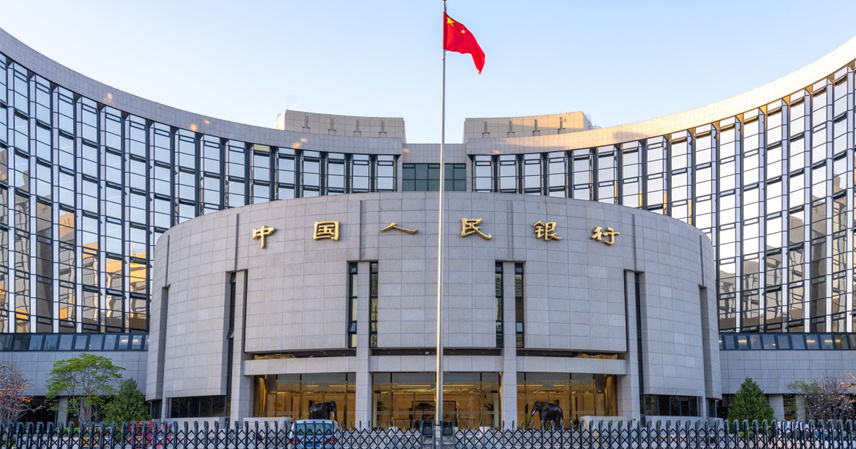China’s central bank has once again stepped up its efforts to stabilize liquidity. On October 15, the People’s Bank of China (PBoC) conducted a ¥600 billion (approx. $82 billion) reverse repurchase operation with a six-month term (182 days) to ensure ample liquidity within the banking system.
The move reflects the PBoC’s ongoing commitment to maintaining financial stability and supporting economic recovery amid a volatile global environment. Analysts say it marks the fifth consecutive month of mid-term liquidity injections through reverse repos, a sign that Beijing is continuing to prioritize financial easing over tightening.
A Fifth Consecutive Month of Liquidity Support
According to PBoC data, ¥500 billion worth of six-month reverse repos were due to mature in October. By launching a ¥600 billion operation, the central bank effectively rolled over and expanded liquidity by ¥100 billion.
Earlier in the month, on October 9, the PBoC also conducted ¥1.1 trillion in three-month reverse repos, exceeding the month’s maturity volume by ¥300 billion. Combined, the two operations resulted in a ¥400 billion net liquidity injection, up by ¥100 billion from September.
This consistent expansion shows the central bank’s preemptive approach to offset potential liquidity frictions caused by government bond issuance or short-term funding pressures.
Analysts: Policy Aims to Smooth Market Volatility
Financial analysts interpret this move as a strategic preemptive injection rather than emergency easing.
Zhou Guannan, chief fixed-income analyst at Huachuang Securities, noted that by injecting liquidity early, the PBoC aimed to smooth the rollover impact of maturing operations and maintain short-term funding stability.
“Given limited fiscal pressure in October and the lack of major bond issuance, liquidity risks remain manageable,” Zhou added.
Similarly, Wang Qing, chief macro analyst at Orient Securities, stated that “the recent rise in global volatility will likely push the PBoC to maintain a more accommodative stance to stabilize expectations.”
Monetary Policy: A Balance of Timing and Precision
The latest PBoC monetary policy committee meeting emphasized “enhancing the precision, foresight, and effectiveness” of policy implementation. The central bank pledged to ensure that liquidity, credit growth, and social financing remain aligned with economic and price targets.
In practical terms, this means that while the PBoC continues to support ample liquidity, it also seeks to avoid excessive easing that might fuel asset bubbles or currency depreciation.
Brokerage reports suggest that the PBoC’s operations are closely tied to domestic fiscal dynamics, including the pace of local government bond issuance and the rollout of new policy-backed financing tools.
Market Impact: Calm Rates, Limited Pressure
Research from Tianfeng Securities noted that funding rates are expected to stay stable through mid-October, supported by fiscal spending, cash inflows after the National Day holiday, and sustained liquidity injections.
However, the report cautioned that volatility could rise later in the month due to payment settlements and tax remittances, making the timing and scale of central bank operations crucial in balancing liquidity supply and demand.
Economists at CITIC Securities expect the Medium-Term Lending Facility (MLF) and reverse repos to remain key policy instruments in the near term. They believe that the interest rate spread between market funding and policy rates will likely remain stable, signaling policy continuity rather than abrupt easing.
Looking Ahead: Possible RRR Cut and Long-Term Liquidity Shift
Analysts widely expect the PBoC to maintain moderate monetary easing through the rest of 2025.
Zhou Guannan predicts that if funding pressure rises in late October, the central bank may continue its “expanded rollovers” of the MLF.
Wang Qing suggested that while medium-term liquidity injections may moderate compared with earlier months, the central bank could initiate another reserve requirement ratio (RRR) cut in the fourth quarter to release long-term funds into the system.
A potential RRR reduction, together with new policy-oriented financial instruments totaling ¥500 billion, could further support infrastructure investment and stabilize the property market—two critical components of China’s growth agenda.
Meanwhile, Zheshang Securities expects room for a 50 basis point RRR cut and a 10 basis point policy rate reduction by year-end, as part of a broader effort to offset weak domestic demand.
Bond Market and Fiscal Coordination
Recent signals from the Ministry of Finance and the PBoC also point to closer fiscal-monetary coordination. In September, both institutions held a joint working meeting to discuss potential open-market operations involving government bonds.
Data from CITIC Securities showed that by the end of August, the PBoC’s balance sheet item “claims on the central government” had fallen by ¥580 billion, implying natural maturities of previously purchased bonds. Analysts believe this could lead to liquidity tightening unless the PBoC restarts sovereign bond purchases to offset the drain.
If resumed, such operations would mark a symbolic policy evolution—bringing China’s monetary tools closer to modern balance sheet management used by major central banks like the Federal Reserve and European Central Bank.
Conclusion: Liquidity First, Tightening Later
Overall, the PBoC’s October operations reinforce a pro-liquidity, risk-control stance. While policymakers are cautious about inflation and debt levels, they remain focused on stabilizing credit conditions and ensuring adequate funding for government-led investments.
As external uncertainties persist—from U.S. interest rate cycles to global supply chain disruptions—China’s monetary strategy seems increasingly defined by flexibility and gradualism, favoring measured injections over aggressive stimulus.
For investors, this signals that policy rates will remain steady and liquidity abundant through the end of the year, laying the groundwork for fiscal expansion and market confidence restoration in early 2026.
References
- People’s Bank of China official statement (Oct. 15, 2025)
- Huachuang Securities Research Report, Oct. 2025
- CITIC Securities Macro Analysis, Oct. 2025
- Tianfeng Securities Market Outlook, Oct. 2025



